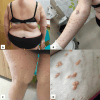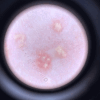Cutaneous Manifestation of Eruptive Xanthoma as a Consequence of Severe Hypertriglyceridemia: A Case Report Highlighting Diagnostic and Therapeutic Challenges
- PMID: 40034640
- PMCID: PMC11875218
- DOI: 10.7759/cureus.78329
Cutaneous Manifestation of Eruptive Xanthoma as a Consequence of Severe Hypertriglyceridemia: A Case Report Highlighting Diagnostic and Therapeutic Challenges
Abstract
Eruptive xanthomas are clinical manifestations of lipid-laden foam cells in the dermis. The morphological subtype and anatomical location of xanthomas can provide insight into the underlying lipid disorder. Hyperlipidemia, a common condition in the general population, is categorized as primary or secondary depending on disruptions in endogenous or exogenous lipoprotein pathways. We describe the case of a 29-year-old female with severe obesity who presented with numerous yellow papules on the trunk, buttocks, and extensor surfaces of the lower limbs, persisting for three months without subjective symptoms. Examination revealed inflammatory halos around some of the lesions. Dermoscopy showed irregularly shaped, light-yellow areas on a dense, yellowish background. Laboratory investigations revealed extreme hypertriglyceridemia (>4000 mg/dL), elevated total cholesterol (>1000 mg/dL), reduced high-density lipoprotein (HDL) and low-density lipoprotein (LDL) levels and undetectable aminotransferase levels. The patient met the criteria for metabolic syndrome and was newly diagnosed with diabetes mellitus. A diagnosis of eruptive xanthomas was made, linked to impaired triglyceride clearance and hepatic overproduction of triglyceride-rich lipoproteins secondary to diabetes, obesity, excessive caloric intake, and oral contraceptive use. The Fredrickson classification system identified hypertriglyceridemia as part of types I, IV, and V hyperlipoproteinemia. This case highlights the significance of a comprehensive diagnostic approach in patients with xanthomas, taking into account associated risk factors, family history, and lipoprotein abnormalities for early detection. Prompt treatment can lead to the complete resolution of eruptive xanthomas and prevent fatal complications such as acute pancreatitis.
Keywords: eruptive xanthomas; hypertriglyceridemia; lipid disorders; lipid-laden foam cells; metabolic syndrome; obesity.
Copyright © 2025, Morka et al.
Conflict of interest statement
Human subjects: Consent for treatment and open access publication was obtained or waived by all participants in this study. Conflicts of interest: In compliance with the ICMJE uniform disclosure form, all authors declare the following: Payment/services info: All authors have declared that no financial support was received from any organization for the submitted work. Financial relationships: All authors have declared that they have no financial relationships at present or within the previous three years with any organizations that might have an interest in the submitted work. Other relationships: All authors have declared that there are no other relationships or activities that could appear to have influenced the submitted work.
Figures
References
-
- Eruptive xanthomas. Tang KY, Wu MY, Li J. https://doi.org/10.1001/jamadermatol.2022.5834. JAMA Dermatol. 2023;159:449. - PubMed
-
- Eruptive xanthomas as a marker for metabolic disorders: a specific form of xanthoma that reflects hypertriglyceridemia. Ohtaki S, Ashida K, Matsuo Y, et al. https://doi.org/10.1002/ccr3.5671 Clin Case Rep. 2022;10:0. - PMC - PubMed
-
- Diabetic dyslipidemia with eruptive xanthoma. Hsueh YC, Chou CL, Lee TI. https://doi.org/10.3949/ccjm.86a.18104. Cleve Clin J Med. 2019;86:575–576. - PubMed
-
- Lipid disorders and cardiovascular risk: a comprehensive analysis of current perspectives. Wazir M, Olanrewaju OA, Yahya M, et al. https://doi.org/10.7759/cureus.51395 Cureus. 2023;15:0. - PMC - PubMed
-
- The differences in the prevalence of cardiovascular disease, its risk factors, and achievement of therapeutic goals among urban and rural primary care patients in Poland: results from the LIPIDOGRAM 2015 study. Studziński K, Tomasik T, Windak A, et al. https://doi.org/10.3390/jcm10235656. J Clin Med. 2021;10:5656. - PMC - PubMed
Publication types
LinkOut - more resources
Full Text Sources
Miscellaneous



